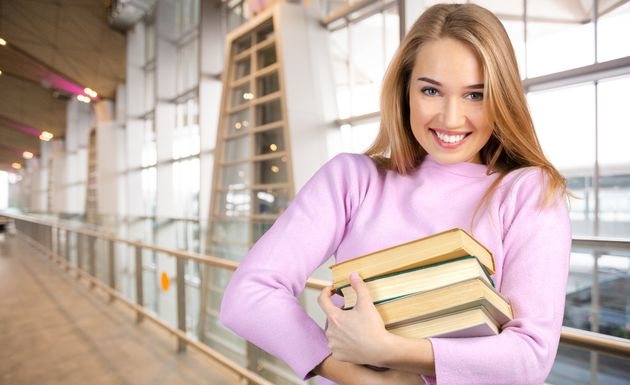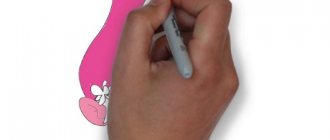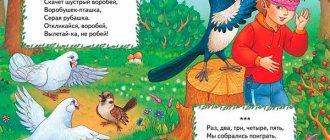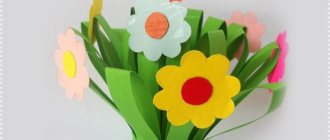Direct educational activities in preschool educational institutions according to the Federal State Educational Standard
Federal State Educational Standard is a federal state educational standard developed for the comprehensive development of the individual.
When drawing up a program for preschool institutions, the following are taken into account:
- individual capabilities and aspirations of the student;
- cooperation and desire for contact with adults;
- the nature of interaction with children and adults;
- respectful attitude towards peers and parents.
The Federal State Educational Standard controls that the educational process is indirect; both the student and the adult must be involved in learning.
Previous strictly regulated forms of education are becoming more flexible, meeting the capabilities and needs of children of primary, middle and senior preschool age.
The main goals that the Federal State Educational Standard faces when raising children in preschools:
- physical development;
- speech development;
- development of communication skills;
- personal development;
- development of motivation;
- development of socialization;
- development of cognitive interest;
- development of artistic skills and aesthetic taste.
Children of early preschool age implement the above skills through educational games with composite toys, physical exercises, experiments with various substances, household items, communication with peers and older children. Together with the teacher, musical works, paintings, fairy tales and poems are analyzed.
For children of senior preschool age, didactic games are role-playing in nature, preschoolers learn to follow rules and hierarchy, classes are exploratory in nature, self-service is taught, and household work skills are developed. Folklore, history, and fiction are studied in the lessons.
The modern educational system involves not only natural, paper and other application materials. Information technology products are also included, problem situations projected in a game format are considered and played out.
The task of the teacher in this case is to organize the educational process in such a way that the child develops comprehensively, intellectually, socially, and shows interest in the world around him and initiative in work activities.
The main activities of a preschool teacher
In preschool activities, mental, moral, labor, physical and artistic-aesthetic education are distinguished, but in recent years more and more attention has been paid to environmental and legal education. This is due to the fact that the socio-economic and political situation in the country and throughout the world is rapidly changing, and modern children in these areas are much better developed than their peers of previous years. In addition, the requirements for the development of a full-fledged personality provide for the all-round development of the child, so ignoring the issues of modern times will not bring anything good. Preschool teachers have to use much more knowledge and skills than in previous years, as this is required by the environment and the changed rules for assessing the activities of the teacher and the requirements for them.
The main directions of the teacher’s pedagogical activity include the following sections:
- Self-education.
- Organization of problem-search work for a children's team.
- Expanding the skills and abilities of students through the introduction of new information technologies into their activities.
- Expanding the educational space of pupils.
- The use of special classes to prepare students for school using ICT.
- Expanding the teacher’s own horizons and educational space using the latest information technologies.

The work of preschool teachers and educators is carried out in different directions, but, in essence, is aimed at one most important goal - the formation of a child as an integral creative personality. Therefore, one of the most important tasks of any educator is the harmonious unification of all areas of their activities to achieve their goal.
In the pedagogical literature, there are often 5 main areas of activity of a teacher in a preschool educational institution. These concepts resonate with the job responsibilities of a teacher, but do not copy, but complement them.
You can find many different definitions of the main directions of a teacher’s work, but they all, in essence, boil down to the following brief and succinct formulations:
1. Care.
2. Education.
3. Supervision.
4. Organization of educational work.
5. Conducting educational work.
This can be deciphered as follows:
- Care is caring, patronizing and providing assistance to a pupil. It concerns both training and education, and purely human feelings, as well as the health of the child. The teacher creates a psychologically healthy atmosphere in the children's educational institution, thanks to which the child feels calm, confident, and safe.
- Education is a broad concept that includes both the inculcation of universal human norms and the formation of a free, fully and comprehensively developed personality.
- Supervision involves monitoring not only behavior and academic performance, but also identifying various violations for the purpose of their subsequent correction and correction.
- Organization of educational work is planning and preparation of the entire learning process in a preschool educational institution. It includes numerous stages - from self-education to the production of the necessary visual material.
- Carrying out educational work is the actual learning process, which involves all the knowledge and skills accumulated by the teacher.
Also, the directions of the teacher’s work can be formulated as follows:
- Sports and recreation.
- Spiritual and educational.
- General cultural.
- General intellectual.
- Social.
The presence of several formulations does not introduce different interpretations into the definition of directions of educational activity, but only explains, “deciphers” them.
Ways to organize children
All of the above problems are solved in various ways. Sometimes completely opposite approaches are taken for different children.
The following characteristics are taken into account in groups:
- a variety of toys and equipment in kindergarten;
- age characteristics of children;
- safety of indoor conditions;
- children's physical fitness level;
- teacher qualification level.
Physical exercises are taken as examples, but the process, goals, methods and teacher participation remain similar during educational lessons.
Frontal
The main goal of the pedagogical process is the acquisition and consolidation of children’s motor skills. They work actively and constantly interact with the teacher.
All movements are performed by children simultaneously and synchronously.
In large groups, it is difficult for an adult to pay attention to each student, and therefore improve the quality of movements.
Individual
Each exercise is performed alternately by children in a chain. While one does it, the rest observe and analyze.
The main advantage of the approach is the strict quality of execution. The main drawback is the passivity of other preschoolers. Effectively used at an older age to learn complex exercises.
In-line
To ensure high motor activity, children perform several exercises at once, in a circle, changing settings and equipment.
This is useful for developing endurance, but it is difficult for an adult to keep track of how each child performs the exercise correctly.
Group
Children are divided into several subgroups, where each performs their own task, after which they change. Useful for physical development and developing acceptance of responsibility for one’s actions.
In this method, the teacher has practically no opportunity to find and correct the student’s mistakes.
Classification of GCD in kindergarten
Direct educational activities in a preschool institution have their own classification:
- Combined. Simultaneous combination of various types of activities: musical, fine arts, mathematical, gaming.
- Integrated. The lesson has one topic, the disclosure of which can be achieved using various methods. The topic can be developed over several lessons and touch on other related aspects. The lesson is necessary not only for learning new material, but also for a deeper understanding of existing knowledge.
- Comprehensive. Demonstrative material already familiar to children is used. It is reinforced no more often than once a quarter in a music, art or other lesson related to the direction in art (reading fairy tales, singing songs, theatrical performances).
- Non-traditional. Lessons are conducted through gatherings, competitions, writing fairy tales, press conferences, fictional journeys, competitions, etc. More detailed variable information is presented in the table below.
Comparative analysis of types of classes in preschool educational institutions according to the Federal State Educational Standard
| 1 | Comprehensive direct educational activities | Application of traditional activities and arts |
| 2 | Integrated direct educational activities | An open lesson, the task of which is to reveal one vital topic. |
| 3 | The main topic is educational activities | The dominant task is the development of moral and ethical knowledge |
| 4 | Collective educational activities | Writing a letter to a friend, composing a fairy tale one sentence at a time and another |
| 5 | Excursion | Visiting nearby district institutions, schools, other kindergarten rooms, libraries to broaden your horizons, develop independence and lack of feelings of fear and uncertainty, develop a sense of adulthood |
| 6 | Direct educational activity - labor | Assistance in cleaning the site, planting green spaces to encourage people to work, natural history knowledge |
| 7 | Creation | Verbal creativity of children |
| 8 | Gatherings | Studying folklore |
| 9 | Fairy tale | Speech development of children |
| 10 | Press conference | Children take on the role of journalists and ask questions to their favorite characters (from fairy tales, films, representatives of their favorite professions) |
| 11 | Journey | Organizing an excursion where the guide is the preschooler himself |
| 12 | Experiment | Children study the physical properties of various materials (kinetic sand, plasticine, cardboard, paper, snow) |
| 13 | Contest | Teachers organize thematic competitions for children, similar to the games “The Smartest?”, “Brain Ring”, etc. |
| 14 | Drawings-essays | The guys create drawings and then have to interpret them and come up with a plot |
| 15 | Conversation | Addressing ethical topics, talking with adults about the child’s behavior |
A variety of types and types of educational activities in a preschool institution
Types of classes: classical, comprehensive, thematic, final, excursions, group, games, labor.
A classic lesson in a preschool educational institution has the following features:
— Structure of a classical lesson;
— Start of class;
— Involves organizing children.
Switching children's attention to the upcoming activity, stimulating interest in it, creating an emotional mood, precise and clear instructions for the upcoming activity (sequence of task completion, expected results).
Progress (process) of the lesson
Independent mental and practical activity of children, fulfillment of all assigned educational tasks.
During this part of the lesson, individualization of training is carried out (minimal assistance, advice, reminders, leading questions, demonstration, additional explanation). The teacher creates conditions for each child to achieve results.
End of class
Dedicated to summing up and assessing the results of educational activities. In the younger group, the teacher praises for diligence, the desire to complete the work, and activates positive emotions. In the middle group, he takes a differentiated approach to assessing the results of children’s activities. In the senior and preparatory school groups, children are involved in the assessment and self-assessment of results.
Depending on the section of training and the goals of the lesson, the methodology for conducting each part of the lesson may be different. Private methods provide more specific recommendations for conducting each part of the lesson. After the lesson, the teacher analyzes its effectiveness, the children’s mastery of program tasks, reflects on the activity and outlines the prospects for the activity.
Complex - the implementation of tasks through different types of activities with associative connections between them (a conversation about fire safety rules turns into drawing a poster on the topic). At the same time, one type of activity dominates, and the second complements it and creates an emotional mood.
A complex activity is one aimed at a comprehensive disclosure of the essence of a certain topic through different types of activities that consistently change each other.
Integrated - combine knowledge from different educational fields on an equal basis, complementing each other (considering such a concept as “mood” through works of music, literature, painting).
1. Classic lesson
According to the old classic form: explanation, completion of the task by children. Results of the lesson.
2. Complex (combined lesson)
Using different types of activities in one lesson: artistic expression, music, visual arts, mathematics, design, manual labor (in different combinations).
3. Thematic lesson
It can be complex, but subordinated to one theme, for example, “Spring”, “What is good”, “our toys”, etc.
4. Final or test lesson
Finding out how children have mastered the program over a certain period of time (six months, quarter, academic year).
5. Excursion
To the library, studio, post office, field, construction site, school, etc.
6. Collective creative work
Collective drawing, collective application: building a street in our city.
7. Occupation-work
Planting onions, cuttings of plants, planting seeds, etc.
8. Activity-game
“Toy store”, “Let’s arrange a room for the doll.” Option: Auction activity - whoever tells the most about the item buys it.
9.Creativity activity
Workshop of an artist, folk craftsmen, storyteller, “Workshop of Good Deeds” (crafts made from waste, natural materials, paper using TRIZ elements).
10. Gathering activity
Based on folklore material, against the backdrop of work, children sing, make riddles, tell fairy tales, and dance in circles.
11. Lesson-fairy tale
The entire lesson is based on the plot of one fairy tale, using music, visual arts, and dramatization.
12. Lesson press conference
Children ask questions to the “astronaut”, “traveler”, “fairy tale hero” and he answers the questions, then the “Journalists” draw and write down what interests them.
13. Landing lesson
Urgent Care. Example. We go from the opposite: during drawing, we ask children about what they can’t do or do poorly. Today we will draw this, those who are good at it will help us. Option: joint activity of children of the older and younger groups (co-creation). The older ones, for example, make the background, the younger ones draw what they can.
14. Commented training session
The whole group of children is given the task of forming the number “7”. One of the children speaks out loud how he makes up a given number, the rest silently do it; if the speaker makes a mistake, a discussion begins. Options: the teacher draws on the board, the children comment on the image, make up a story, or the teacher draws what the children are talking about.
15. Travel activity
The goal is to develop children's monologue speech. One of the children is a “tour guide”, the rest of the children ask questions. Options: travel through fairy tales, native country, city, republic, to the “Land of Cheerful Mathematicians”, according to the “Red Book”.
16. Discovery lesson (problem lesson)
The teacher offers the children a problem situation, the children solve it together and make a discovery. Example: “What happens if paper disappears?”, “Why study?” Option: “The investigation is being conducted by experts.”
17. Lesson-experiment
For example, a child is given paper. He does not do everything he wants with him - tears, crumples, wets, etc. Then he draws his own conclusion. Options: with ice, snow, magnet, air.
18. Activities-drawings-essays
The teacher draws, the children make up stories. Children make up stories based on their drawings. Children “write” a letter-drawing about an event in kindergarten.
19. Lesson-competition
Like: “What, where, when?” Competition of dreamers, poems, fairy tales.
Children are divided into teams, issues are discussed together, the captain speaks, and the children complement.
Options: “Neznaykin Bridge”. Various questions are asked, and for the correct answer the team receives a “log” to build a bridge to the opposing team. For an incorrect answer, the “log” sinks to the bottom of the river. The winner is the one who builds the bridge across the river faster, i.e. will give more correct answers.
20. Group classes (competition option)
Children are organized into groups. For example, for 4 seasons. They prepare for the lesson in secret. During the lesson they talk, “defend” their season, draw, and tell invented stories. The winner is the one who makes the most interesting speech defending his season (books, toys, etc.).
21. “Game-school”
School for astronauts (athletes), school for forest dwellers (animals), school for young drivers and pedestrians. They talk about themselves, sing, dance, pantomime, etc.


